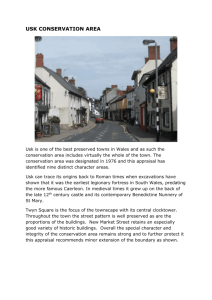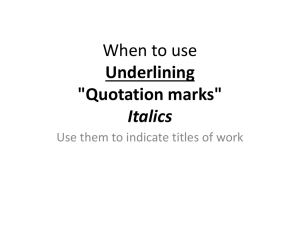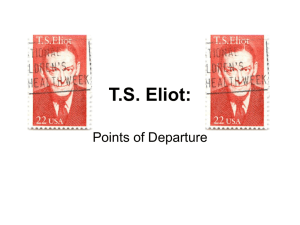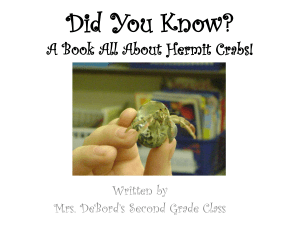usk-powerpoint - DHS Book Babes
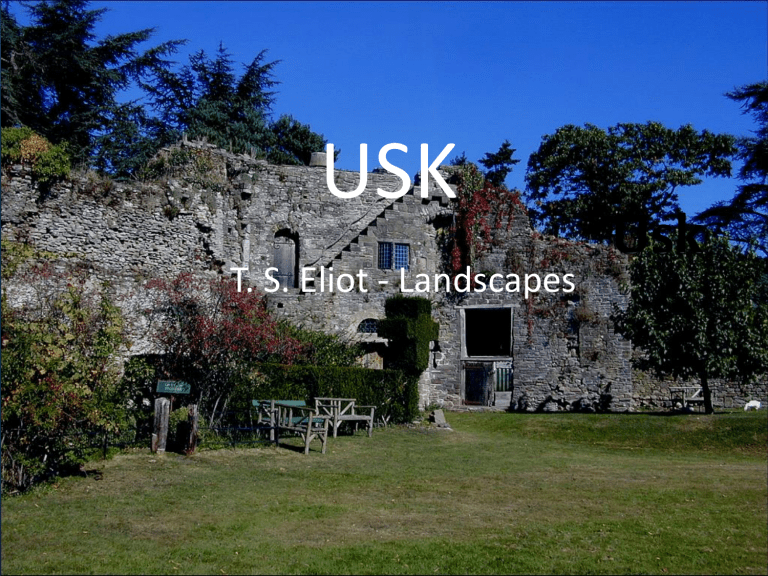
USK
T. S. Eliot - Landscapes
About Usk
Usk is a small town in south east Wales which is located on the River Usk, which is spanned by an arched stone bridge at the western entrance to the town. A castle above the town overlooks the ancient crossing point
Usk was the earliest legionary fortress in Wales.
Although the site was constricted by hills, subject to flooding, and not on a navigable river.
“Do not suddenly break the branch, or hope to find”
The enjambment after the word
“or”, suggests a hesitance following the initial command of “do not…” – it is as if the subject has gone against the speaker’s wishes and the tone end of the line changes.
“The white hart over the white well.”
This connotates a fairytale-esque image, as white harts (deer in old English terminology) are deemed rare.
This could link to Eliot’s view that people should not travel to Usk to tamper with old myth, magic and enchantment.
“Glance aside, not for lance, do not spell
Old enchantments. Let them sleep.
‘Gently dip, but not too deep’”
These lines link to the previous point referring to the fact that the history of the land should not be resurrected or disturbed. The use of enjambment following
‘spell’ could perhaps suggest caution from the speaker of the poem. Following this, a quote is presented, referring to the well, as if this was a valuable piece of advice once given to the voice of the poem, which he is now passing on to the reader.
“Lift your eyes where the roads dip and where the roads rise”
Between 1154 and 1170, Richard de Clare, 2nd Earl of
Pembroke established a planned town, surrounded by an earthen rampart – Eliot refers to the rampart (a defensive structure, often in the form of a mound of earth, stone or embankment) when he mentions the dip and rise in the road. He is telling the reader to contemplate the reality of the history of the town – which is of violence and bloodshed as opposed to myth and fairytale.
“Seek only there where the grey light meets the green air.”
The grey light meeting the green air suggests a reference to the violent border disputes between the English and
Welsh during the Norman times. It could also refer to the Battle of Pwll Melyn in 1405 which occurred immediately north of Usk Castle, when English forces routed their Welsh opponents, causing much loss of life. After their defeat, three hundred Welsh prisoners were executed in front of the castle.
“The Hermit’s Chapel, the pilgrim’s prayer.”
This line is fairly ambiguous, however it could link to St
Govan’s chapel in Pembrokeshire which is commonly referred to as the Hermit’s Chapel, as St Govan lived there as a Hermit (a person who lives in seclusion from society).
This line directly following the one in the previous slide shows the contrast between the violent history of the town and the mythological preferred view of Usk.
Summary
Rhyme scheme – The opening two lines of the poem have a non-existent rhyme scheme, this could be because the speaker’s intention was to command and to prevent an action occurring – however, once the
“branch has been broken” the poem shifts into a ballad form and the rhyme scheme develops into a simple
AA, BB, CC, DDD form.
